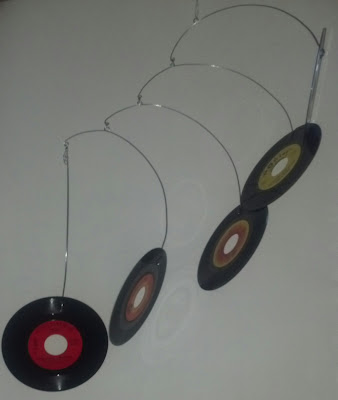Kinetic art mobiles make a great design element in any room or outdoor space. The movement of a mobile catches the eye and fascinates the viewer. The Vinyl Record Mobile Tutorial shows the construction method for a wave style mobile with fixed planes. While this mobile is made from vinyl records, this project could be adapted to use cardboard, metal sheets or other materials. One of the benefits of using recycled vinyl records is that the mobile may be hung outside. This design uses 45rpm records. LP records could be used for a larger mobile.
Warnings: This project involves fire, sharp objects and fumes. This mobile should be made outdoors or in a very well ventilated area.
Materials: 16 gauge galvanized wire, vinyl records, ruler, awl, needle nose pliers, candle
Prepping the Vinyl Records
Before the records can be attached to the arms of the mobile, they must be cleaned & have 2 holes punched for the wire attachment. Records that are no longer playable can be cleaned with window cleaner or water & dish detergent. Hot water should not be used as it can warp the vinyl.
To begin the punching process, start by determining the spacing of the two holes. Mark the spacing on a ruler. Place the record on a box with a hole cut in the side with the area to be punched over the hole. The hole will allow the awl to pass through.
Heat awl over a flame. Failing to adequately heat the awl will cause the record to crack or shatter.
Using the ruler as a guide, press the tip of the awl into the vinyl. If the awl is hot enough, it should melt through the vinyl forming a hole. Applying too much pressure will cause cracking. Repeat for the second hole.
Arm Construction
The arms of the mobile are constructed one at a time from the bottom up. Each arm is attached as it is made. For the wave style mobile, all arms are identical except the bottom most arm. The bottom arm ends in a spiral while the upper arms are attached to the next lowest arm. This mobile has a total of five arms. The number of arms can be changed to make a larger or smaller mobile.
Decide how many arms the mobile will have. Cut a length of wire for each arm. Five pieces of 18" long 16 gauge wire are used in this mobile.
Lessen the curve of each arc of wire by pulling wire firmly between fingers. Try not to make bends or bumps while straightening the wire.
Each piece of wire should be a smooth gentle curve. Repeat this for all of the arms, trying to make the pieces similar.
Using the same measurements as the holes in the records, make a hook in one end of the wire arm. The short end of the hook should be slightly shorter than the distance between the holes. The hook should be formed under the arc of wire.
Thread the hook through the 2 holes in the record. Be careful not to bend the record as this will cause cracking. Hold the arm coming off the record firmly while using the pliers to bend the hook into place.
Attaching the record in this way keeps it in a fixed plane relative to the arm. Mobiles using fixed planes catch wind easier than mobiles with free moving planes.
For the bottom most arm, use the the pliers to make a spiral in the end of the arm opposite the record. The spiral can curve above or below the arm arc.
For the upper arms, use the pliers to make a hook in the end of the arm opposite the record. The hook should curve under the arm arc.
The final step in arm construction is creating a hanging loop at the arm's balance point. The balance point forms the axis around which the arm will rotate. A centered balance point will yield a horizontal arm. This mobile's arms are at an angle, so the balance point is 3" from the edge with the spiral or hook. The hanging loop should always be above the arm.
Begin making the hanging loop by gripping the wire with pliers at the balance point. The wire should be curving downwards from the pliers. Bend one side of the wire upward as close to the pliers as possible.
Loop the wire around the tip of the pliers.
Use the pliers to squeeze the loop into a circular shape.
Using the pliers, bend a 1-2" piece of wire into an open ring, like a jewelry jump ring.
Thread the small ring through the hanging loop on the arm. Pinch the ring closed. This ring gives the arm freedom of movement.
Arm Attachment
To attach arms, thread the open hook on the end of the upper arm through the small ring on the hanging loop of the lower arm.
Using pliers, bend the hook on the upper arm into a closed loop.
Repeat this process until all of the arms are attached. The top arm's hanging loop ring is used to hang the mobile.
























No comments:
Post a Comment